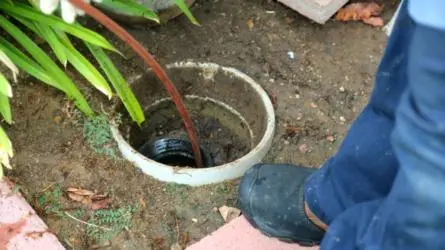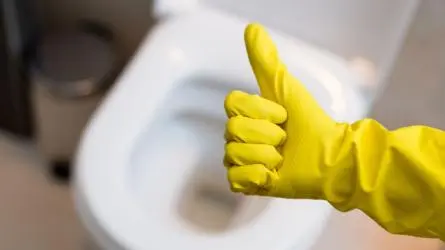A clogged or blocked toilet can be a frustrating and unpleasant nightmare, often occurring at inconvenient times. While a normal plunger or a toilet plunger are the traditional tools for unblocking a toilet, they might not always be readily available in every household. In such situations, a mop can surprisingly become an unexpected hero, offering a quick and effective solution to clear the stubborn blockage.
This easy method can save you the hassle and cost of calling a plumber, especially in emergencies when you can’t get professional help right away. It’s a straightforward solution that’s worth trying before reaching for the phone.
Preparing the Mop
Get your mop ready. Pick a sturdy mop with a long handle – rubber or plastic works best because it’s less likely to slip or snap while you’re working. Make sure it’s clean, too – the last thing you want is to make the situation messier
Either remove the mop head or grab a spare one for this job. Ensure the handle is clean and free of any debris because the last thing you want is to add more gunk to the problem.
Step-by-Step Guide

Step 1: Create a seal around the toilet bowl
Seal it up. Start by angling the mop handle into the toilet bowl to create a snug seal around the opening. This seal is key – it lets you build the suction you’ll need to get that clog moving
Step 2: Insert the mop handle into the toilet
Carefully insert the mop handle into the toilet’s drain opening, ensuring it goes down as far as possible without forcing it. This will allow you to reach and dislodge the clog effectively.
Step 3: Plunge the mop handle up and down
With the mop handle securely in place, begin plunging it up and down with firm, consistent strokes. Apply enough force to create suction and pressure, but avoid excessive force that could damage the toilet or cause the mop handle to break.
Step 4: Add water if the bowl is low
If the water level in the toilet bowl is low, consider adding more water or even hot water to increase the hydraulic pressure and aid in dislodging the clog. However, be cautious when filling the bowl, as this could lead to an overflow.
Step 5: Repeat the plunging motion until the clog is cleared
Stick with it! Keep repeating the plunging motion, trying different angles and depths. You’ll know you’re successful when the water drains smoothly. But if the stubborn clog refuses to budge after several tries, it might be time to consider another method or call in the experts.
Tips and Tricks

- Use a mop with a rubber or plastic handle for better grip and durability.
- Don’t forget the essentials: slip on some rubber gloves to keep things hygienic, and keep a bucket or a few towels close by to handle any splashes or spills – better safe than sorry!
- Have a bucket or towels nearby to catch any splashes or overflow during unclogging.
- Try different angles and depths for the mop handle to find the most effective position for dislodging the clog.
- If the clog is caused by too much toilet paper, try using a toilet brush or a wire coat hanger to break it up before plunging.
- Consider using a mixture of baking soda and white vinegar for stubborn clogs. Pour the baking soda into the toilet bowl, followed by the vinegar. Let the mixture fizz for a few minutes, then flush with hot water.
- Avoid flushing inappropriate items such as wet wipes, sanitary products, or excessive amounts of toilet paper, as these can easily cause blockages.
- If the clog is particularly stubborn, add boiling water to the toilet bowl before attempting the mop method.
When Do You Need A Plumber?

While the mop unclogging method can prove effective for minor toilet clogs, there are instances where more is needed. If you’ve made multiple attempts with the mop and the clog persists, or if you suspect a more severe blockage, you should seek professional help from a licensed plumber.
Signs that you may need to call a plumber include:
- Persistent Clog: If the clog remains stubbornly in place despite your best efforts with the mop, it could indicate a more significant obstruction deeper within the plumbing system.
- Slow Drainage: If the toilet water drains slowly or doesn’t drain at all, even after clearing the initial clog, it may signal an issue with the main drain line or vent stack.
- Multiple Clogged Fixtures: If you’re experiencing clogs in multiple fixtures, such as sinks or bathtubs, it could point to a problem with the main sewer line, which requires professional attention.
- Gurgling Sounds: If you hear gurgling sounds from the toilet or other fixtures, it could indicate a blocked vent pipe or a more serious issue with the plumbing system.
If the clog just won’t budge, it might be a sign of something more serious lurking deeper in your pipes. At that point, DIY fixes could do more harm than good – it’s time to call in the pros.
A licensed plumber has the knowledge, experience, and specialised equipment to diagnose and effectively address the root cause of the blockage. They can perform hydro-jetting, cable snaking, or even video inspections to locate and clear stubborn clogs or identify any underlying issues with your plumbing system.
While the mop method can be a handy and cost-effective solution for minor toilet clogs, it’s essential to recognise when professional assistance is necessary to ensure your plumbing system’s proper functioning and longevity.
Preventing Future Toilet Clogs
To steer clear of frequent toilet blockages, it’s crucial to adopt good habits. One key step is being mindful of what you flush down the loo; it can make all the difference.

Regular cleaning isn’t just about keeping your toilet sparkling – it’s also your best defence against clogs. A quick scrub with a toilet brush and cleaner every now and then can help stop residue and build-up in their tracks. Consider using a specialised drain cleaner formulated for toilets, as these products are designed to break down organic matter and keep your drains flowing smoothly.
Additionally, it’s recommended to flush hot water down the toilet periodically. The heat can help dissolve and dislodge any build-up, preventing clogs from forming.
By taking these simple steps, you can hugely cut down the chances of dealing with annoying clogs in the future. It’ll save you not just time and money but also the headache of calling in a plumber.
Mop Unclogging Method: A Handy Solution for Clogged Toilets
Using a mop to unclog a toilet might sound outside the box, but it’s a handy trick when you’re in a jam and don’t have the usual tools. Follow these steps carefully, and you’ll have your toilet back in working order in no time
However, persistent or severe clogs may require professional assistance from a licensed plumber to ensure the safety and integrity of your plumbing system. With a little ingenuity and the right approach, a simple mop can become a valuable tool in your household arsenal, helping you tackle clogged toilets quickly and efficiently without the worry of calling a plumber for small repairs.
If you’re in the Perth area and facing a stubborn clogged toilet that the mop method can’t resolve, don’t hesitate to contact Woolf Plumbing & Gas. Our experienced professionals have the latest tools and techniques to handle even the most challenging blocked drains, ensuring a prompt and reliable solution. Trust the experts at Woolf Plumbing & Gas to restore your toilet’s functionality and provide peace of mind.




